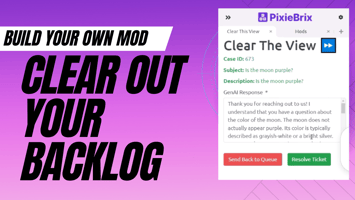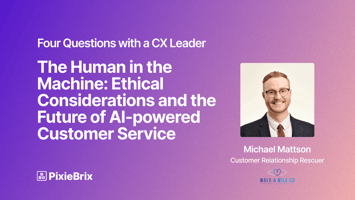👋This is a guest post on the PixieBrix blog written by Craig Stoss , Direct of CX Success at...
Four Questions with CX Leader Craig Stoss
We asked CX Leader, Craig Stoss, a few questions about his experience with Customer Success. Here’s what we heard:
When you look at the tech stack of a customer support team at an earlier stage company, what are the most common gaps?
Craig Stoss: Two things come to mind: The first is integrations not being utilized. Support teams often use a lot of tools to do their role. For example, In e-commerce that might be a shipping or order management tool or it could be a CRM or in-house built admin interface for your product. Often the biggest amount of a ticket resolution time is navigating between these tools, copying data between them, or into your help desk tool, etc. Whether it is via a supported integration or API access, or even an AI solution, having these tools integrate and bring data to the agent automatically will drastically reduce your team's efficiency and remove manual error.The second is the lack of use of the tools fully. The number of customers I work with that use the out-of-the-box help desk email, help center, signature templates without any branding or fail to set up the UI or field data in a way that is efficient for agents and customers is astonishing! When you have a tech stack and are paying for the tools, make sure you are maximizing the value you get from them to minimize effort and confusion for everyone. Small things like the order of fields, or when a field is visible, or if a customer can submit field data from your website can make a big impact on the time to handle a ticket. Or if you are using a chat tool and expect agents to handle multiple chats at the same time, ensure they have shortcut keys or text expansion macros they can use. Use your tools to their full potential.
You’ve worked at in-house customer service teams, and you’ve also supported business process outsourcing (BPO) teams. When’s the right time for a company to bring on a BPO?
Craig Stoss: BPOs can solve many use cases for a company. The right time is when one of those use cases is important to the expansion of your business or the demands of your customers. These include: Multi-language support, support age cover across more time zones or even 24/7, tiered or freemium support models, etc. The attitude that outsourced support is worse than in-house support is largely false these days. The competition is too high and the skills exist everywhere to provide incredible support at scale. The key, in my opinion, is finding a BPO that recognizes your needs. For example, some focus on e-commerce, others on technical support, others only on front line support or text channel only versus omnichannel. One rather newer consideration is what is your potential BPO's AI strategy? Make sure their vision aligns with yours, because if they over index on genAI and that isn't what you want, or the exact opposite, it won't make for a strong partnership. Take the time to speak about your specific use cases and force the potential BPO to answer clearly or show evidence of how they will solve your business needs.
Fintech giant Klarna said its AI assistant was handling two-thirds of customer service chats, completing the work of 700 employees, after being live for one month. Are chatbots taking over Customer Service?
Craig Stoss: Without question, chatbots will slowly take over a chunk of Customer Service. What's important to realize is what AI is great at, which is connecting common questions to repeatable answers. They are not creative. Meaning that current chatbots will not figure out how to solve a new problem or automatically recognize when a workflow changes, so humans will still play a significant role in the training of these tools. In businesses where you have high repeatable questions, a well-trained, tightly constrained, tested chatbot can absolutely have the impact that Klarna saw. What I am seeing in the market is that often the bots are not well trained, are pointing to incorrect data, don't have appropriate persona settings, or don't have the constraints in place to prevent incorrect answers and make the responses robotic. These things lead to the trope of the horrible chat bot, when I would argue the issue isn't the bot technology, it's the implementation of it. If you want to succeed with AI, invest in the training for your team, hiring conversational design experts, or engage with consultants who will ensure the implementation goes well. Finally, my bold prediction is that the customer service that chat bots take over will allow for support agents to take on more of a success role. If they no longer need to deal with the "easier" tickets, then they can start to ask deeper business need questions, provide more proactive, custom responses on the more difficult use case questions and take on parts of customer success' role and your implementation team's role. This will lead to a more personalized servicer, better customer experiences, and a reduction in the need for a success team solely focused on renewals and upsells.
If you could give a VP of Customer Success one piece of advice, what would it be?
Craig Stoss: Following on from the last question, my advice is: Focus on value. Customer Success has drifted over the past 10 years to a focus on renewal and upsell. The result is that many teams have stopped proactively thinking about why their customers came to them in the first place. Your customers bought your product or service because they gained some value and solved some business problems. Listen to your voice of customer feedback, watch for usage patterns for different customer profiles, and add little surprises to your offering and the renewals will be automatic, not something you have to negotiate for. For example, proactively audit a customers' usage of your product. Are they using it correctly? Has it met their original business goals? Has their monthly usage dropped? Have they escalated problems to support recently? Asking these questions more frequently instead of just before a QBR-style meeting shows you care about the value they are getting from your products and want to get them more.
Note: these answers are Craig Stoss’, who has 20+ years of CX experience. These comments do not represent any team or company Craig works for or has worked for.


